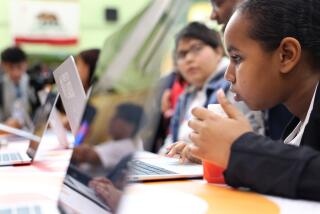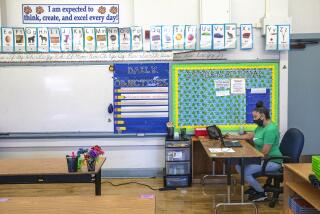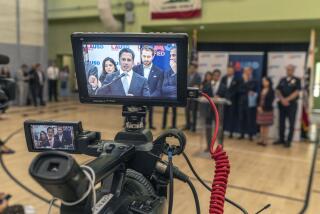High-Tech Teaching
- Share via
IN THE classroom of tomorrow, computers will replace desks, wall-size computer displays will replace overhead projectors, and students will be able to use the Library of Congress at the touch of a button.
But that’s not all. With the expected decrease in computer prices 25 years from now, many Los Angeles schoolchildren will be able to reap the benefits of new technology both at home and school, says Harold F. O’Neil, USC professor of educational psychology and technology.
“Learning will take place in three locations--the school, the home and the community,” agrees Harry Handler, an adjunct professor in UCLA’s Graduate School of Education and former superintendent of the Los Angeles Unified School District. “The objective should be using the computer as a tool in learning; this should be a common experience for every child.”
It will be, says O’Neil, who predicts that computers will be “dramatically cheaper” by 2013. By then, each student will carry a 3x5-inch computer “smart card,” he says. The card will be a battery-operated computer that will have the student’s educational history, as well as a list of all the skills the student has mastered, stored in its memory.
To do homework, the student will plug the card into a home computer, which will later update the smart card’s records to show what the student has completed. Back at school, students will plug their smart cards into their desks, more powerful, voice-input computers whose entire surface will serve as the screen, says O’Neil.
These new “desks” will have an added advantage, he adds. They’ll solve the problem of students and teachers not speaking the same language in the classroom. Thanks to the voice input and output on these computers, there will be an instant translation on the computer screen from English into any other language, or vice-versa, as a student or teacher speaks.
O’Neil also foresees a classroom 25 years from now in which the wall, ceilings and floors are giant computer displays, much like the kind we see today at football games. Another major innovation in education by 2013: Knowledge will be readily available to everyone, thanks to such developments as CD-ROM. This technology--which stands for Compact Disc Read Only Memory and is now being used in the music industry--will play back any kind of computer data, including text, pictures and numbers, explains Carl Stork, director of marketing for the CD-ROM division of Microsoft. The entire Library of Congress could fit on one laser disc 25 years from now. O’Neil stresses that while private schools and wealthier public schools almost certainly will use the new technology, it will be up to public policy makers to ensure that less-fortunate students, too, have access to it. He likes the idea of providing high-tech classrooms for children at risk of dropping out and using it in magnet schools. It’s important to begin such policy discussions, now, he says, so that when the technology is widespread and inexpensive, schools will be ready to put it in place--fairly.
More to Read
Sign up for Essential California
The most important California stories and recommendations in your inbox every morning.
You may occasionally receive promotional content from the Los Angeles Times.










